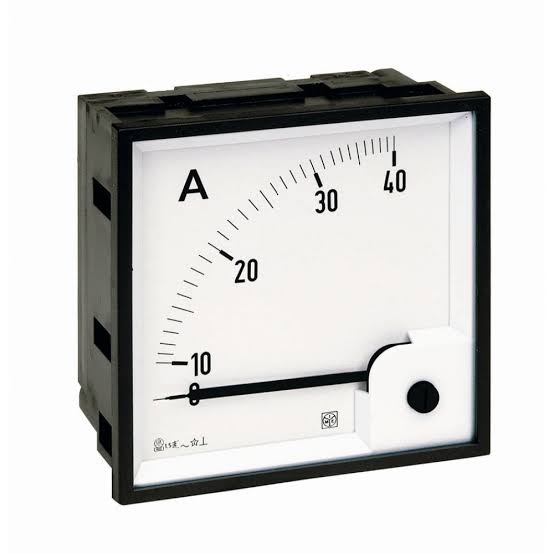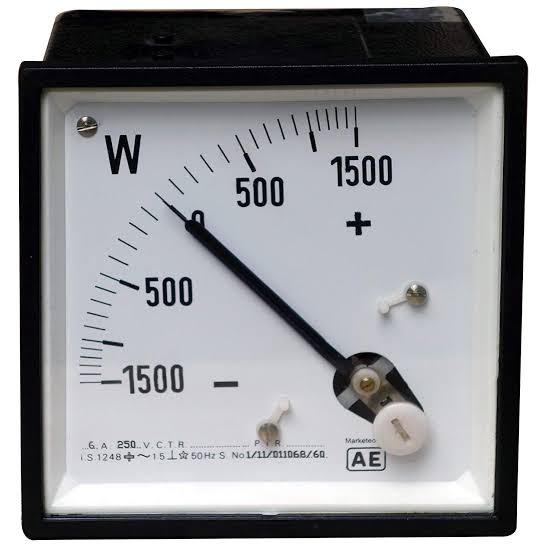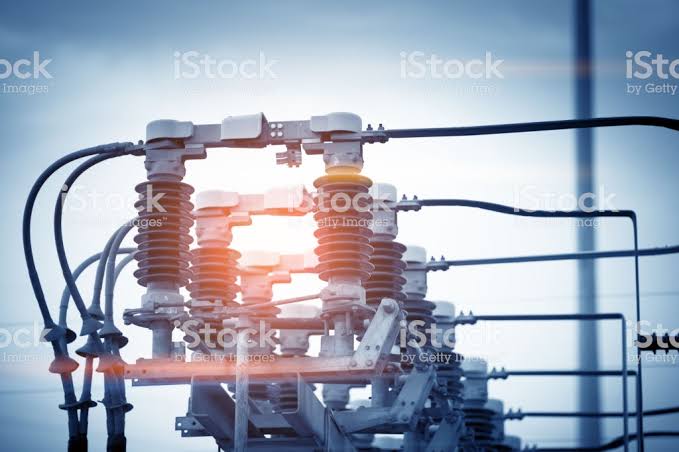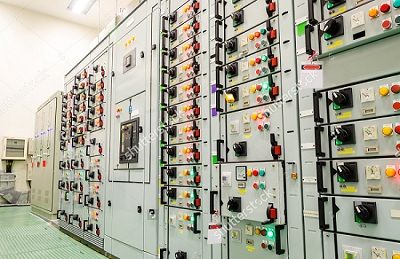Circuit Breaker
A circuit breaker is a piece of equipment which can
(i) make or break a circuit either manually or by remote control under normal conditions
.
(ii) break a circuit automatically under fault conditions
.
(iii) make a circuit either manually or by remote control under fault conditions.
Working principle
A circuit breaker essentially consists of fixed and moving contacts, called electrodes. Under normal operating conditions, these contacts remain closed and will not open automatically until and unless the system becomes faulty. Of course, the contacts can be opened manually or by remote control whenever desired. When a fault occurs on any part of the system, the trip coils of the circuit breaker get energised and the moving contacts are pulled apart by some mechanism, thus opening the circuit.
When the contacts of a circuit breaker are separated under fault conditions, an arc is struck between them. The current is thus able to continue until the discharge ceases. The production of arc not only delays the current interruption process but it also generates enormous heat which may cause damage to the system or to the circuit breaker itself. Therefore, the main problem in a circuit breaker is to extinguish the arc within the shortest possible time so that heat generated by it may not reach a dangerous value.
Methods of Arc Extinction
There are two methods of extinguishing the arc in circuit breakers :
- High resistance method.
- Low resistance or current zero method
- High resistance method.
In this method, arc resistance is made to increase with time so that current is reduced to a value insufficient to maintain the arc. Consequently, the current is interrupted or the arc is extinguished. The principal disadvantage of this method is that enormous energy is dissipated in the arc. Therefore, it is employed only in d.c. circuit breakers and low capacity a.c. circuit breakers.
The resistance of the arc may be increased by :
(i) Lengthening the arc. The resistance of the arc is directly proportional to its length. The length of the arc can be increased by increasing the gap between contacts.
(ii) Cooling the arc. Cooling helps in the deionisation of the medium between the contacts.
This increases the arc resistance. Efficient cooling may be obtained by a gas blast directed along the arc.
(iii) Reducing X-section of the arc. If the area of X-section of the arc is reduced, the voltage
necessary to maintain the arc is increased. In other words, the resistance of the arc path is increased. The cross-section of the arc can be reduced by letting the arc pass through a narrow opening or by having smaller area of contacts.
(iv) Splitting the arc. The resistance of the arc can be increased by splitting the arc into a
number of smaller arcs in series. Each one of these arcs experiences the effect of lengthening and cooling. The arc may be split by introducing some conducting plates between the contacts.
2. Low resistance or current zero method
This method is employed for arc extinction in
a.c. circuits only. In this method, arc resistance is kept low until current is zero where the arc extinguishes naturally and is prevented from restriking inspite of the rising voltage across the contacts. All modern high power a.c. circuit breakers employ this method for arc extinction.
In an a.c. system, current drops to zero after every half-cycle. At every current zero, the arc extinguishes for a brief moment. Now the medium between the contacts contains ions and electrons so that it has small dielectric strength and can be easily broken down by the rising contact voltage known as restriking voltage. If such a breakdown does occur, the arc will persist for another half-cycle. If immediately after current zero, the dielectric strength of the medium between contacts is built up more rapidly than the voltage across the contacts, the arc fails to restrike and the current will be interrupted. The rapid increase of dielectric strength of the medium near current zero can be achieved by :
(a) causing the ionised particles in the space between contacts to recombine into neutral molecules.
(b) sweeping the ionised particles away and replacing them by un-ionised particles.
Classification of Circuit Breakers
here are several ways of classifying the circuit breakers.
- Oil circuit breakers
- Air-blast circuit breakers
- Sulphur hexafluroide (SF6) circuit breaker
- Vacuum circuit breakers
- Oil circuit breakers
In such circuit breakers, some insulating oil (e.g., transformer oil) is used as an arc quenching medium. The contacts are opened under oil and an arc is struck between them. The heat of the arc evaporates the surrounding oil
and dissociates it into a substantial volume of gaseous *hydrogen at high pressure. The hydrogen gas occupies a volume about one thousand times that of the oil decomposed. The oil is, therefore, pushed away from the arc and an expanding hydrogen gas bubble surrounds the arc region and adjacent portions of the contacts The arc extinction is facilitated mainly by two processes. Firstly, the hydrogen gas has high heat conductivity and cools the arc, thus aiding the de-ionisation of the medium between the contacts. Secondly, the gas sets up turbulence in the oil and forces it into the space between contacts, thus eliminating the arcing products from the arc path. The result is that arc is extinguished and circuit current †interrupted.
Advantages
- It absorbs the arc energy to decompose the oil into gases which have excellent cooling properties.
- It acts as an insulator and permits smaller clearance between live conductors and earthed components.
- The surrounding oil presents cooling surface in close proximity to the arc.
Disadvantages
- It is inflammable and there is a risk of a fire.
- It may form an explosive mixture with air
- The arcing products (e.g., carbon) remain in the oil and its quality deteriorates with successive operations. This necessitates periodic checking and replacement of oil.
- Air-Blast Circuit Breakers
These breakers employ a high pressure *air-blast as an arc quenching medium. The contacts are
opened in a flow of air-blast established by the opening of blast valve. The air-blast cools the arc and sweeps away the arcing products to the atomsphere. This rapidly increases the dielectric strength of the medium between contacts and prevents from re-establishing the arc. Consequently, the arc is
extinguished and flow of current is interrupted.
Advantages
An air-blast circuit breaker has the following advantages over an oil circuit breaker:
- The risk of fire is eliminated.
- The arcing products are completely removed by the blast whereas the oil deteriorates with successive operations; the expense of regular oil replacement is avoided.
- The growth of dielectric strength is so rapid that final contact gap needed for arc extinction is very small. This reduces the size of the device.
- The arcing time is very small due to the rapid build up of dielectric strength between contacts. Therefore, the arc energy is only a fraction of that in oil circuit breakers, thus resulting in less burning of contacts.
- Due to lesser arc energy, air-blast circuit breakers are very suitable for conditions where frequent operation is required.
- The energy supplied for arc extinction is obtained from high pressure air and is independent of the current to be interrupted.
Disadvantages
The use of air as the arc quenching medium offers the following disadvantages :
- The air has relatively inferior arc extinguishing properties.
- The air-blast circuit breakers are very sensitive to the variations in the rate of rise of restriking voltage.
- Considerable maintenance is required for the compressor plant which supplies the air-blast.
Applications
The air blast circuit breakers are finding wide applications in high voltage installations. Majority of the circuit breakers for voltages beyond 110 kV are of this type.
- Sulphur Hexaflouride (SF6) Circuit Breakers
In such circuit breakers, sulphur hexaflouride (SF6) gas is used as the arc quenching medium. The
SF6 is an electro-negative gas and has a strong tendency to absorb free electrons. The contacts of the breaker are opened in a high pressure flow of SF6 gas and an arc is struck between them. The conducting free electrons in the arc are rapidly captured by the gas to form relatively immobile negative ions. This loss of conducting electrons in the arc quickly builds up enough insulation strength to extinguish the arc. The SF6 circuit breakers have been found to be very effective for high power
and high voltage service.
Working In the closed position of the breaker, the contacts remain surrounded by SF6 gas at a pressure of about 2·8 kg/cm2
. When the breaker operates, the moving contact is pulled apart and an arc is struck between the contacts. The movement of the moving contact is synchronised with the opening of a valve which permits SF6 gas at 14 kg/cm2 pressure from the reservoir to the arc interruption chamber. The high pressure flow of SF6 rapidly absorbs the free electrons in the arc path to form immobile negative ions which are ineffective as charge carriers. The result is that the medium between the contacts quickly builds up high dielectric strength and causes the extinction of the arc. After the breaker operation (i.e., after arc extinction), the valve is closed by the action of a set of springs.
Advantages
- Due to the superior arc quenching property of SF6, such circuit breakers have very short arcing time.
- Since the dielectric strength of SF6 gas is 2 to 3 times that of air, such breakers can interrupt much larger currents.
- The SF6 circuit breaker gives noiselss operation due to its closed gas circuit and no exhaust to atmosphere unlike the air blast circuit breaker.
- The closed gas enclosure keeps the interior dry so that there is no moisture problem.
- There is no risk of fire in such breakers because SF6 gas is non-inflammable.
- There are no carbon deposits so that tracking and insulation problems are eliminated.
- The SF6 breakers have low maintenance cost, light foundation requirements and minimum auxiliary equipment.
- Since SF6 breakers are totally enclosed and sealed from atmosphere, they are particularly suitable where explosion hazard exists e.g., coal mines
Disadvantages
- SF6 breakers are costly due to the high cost of SF6.
- Since SF6 gas has to be reconditioned after every operation of the breaker, additional equipment is requried for this purpose.
Applications
A typical SF6 circuit breaker consists of interrupter units each capable of dealing with currents upto 60 kA and voltages in the range of 50—80 kV. A number of units are connected in
series according to the system voltage. SF6 circuit breakers have been developed for voltages 115 kV to 230 kV, power ratings 10 MVA to 20 MVA and interrupting time less than 3 cycles.
- Vacuum Circuit Breakers (VCB)
The production of arc in a vacuum circuit breaker and its extinction can be explained
as follows : When the contacts of the breaker are opened in vacuum (10−7
to 10−5 torr), an arc is
produced between the contacts by the ionisation of metal vapours of contacts*. However, the arc is quickly extinguished because the metallic vapours, electrons and ions produced during arc rapidly condense on the surfaces of the circuit breaker
contacts, resulting in quick recovery of dielectric
strength. The reader may note the salient feature of vacuum as an arc quenching medium. As soon as the arc is produced in vacuum, it is quickly extinguished due to the fast rate of recovery of dielectric strength in vacuum.
When the breaker operates, the moving contact separates from the fixed contact and an arc is struck between the contacts. The production of arc is due to the ionisation of metal ions and
depends very much upon the material of contacts. The arc is quickly extinguished because the metallic vapours, electrons and ions produced during arc are diffused in a short time and seized by the surfaces of moving and fixed members and shields. Since vacuum has very fast rate of recovery of
dielectric strength, the arc extinction in a vacuum breaker occurs with a short contact separation (say 0·625 cm).
Advantages
- They are compact, reliable and have longer life.
- There are no fire hazards.
- There is no generation of gas during and after operation.
- They can interrupt any fault current. The outstanding feature of a VCB is that it can break
- any heavy fault current perfectly just before the contacts reach the definite open position.
- They require little maintenance and are quiet in operation.
- They can successfully withstand lightning surges.
- They have low arc energy.
- They have low inertia and hence require smaller power for control mechanism.
Applications
For a country like India, where distances are quite large and accessibility to remote areas difficult, the installation of such outdoor, maintenance free circuit breakers should prove
a definite advantage. Vacuum circuit breakers are being employed for outdoor applications ranging from 22 kV to 66 kV. Even with limited rating of say 60 to 100 MVA, they are suitable for a majority of applications in rural areas.

















0 Comments